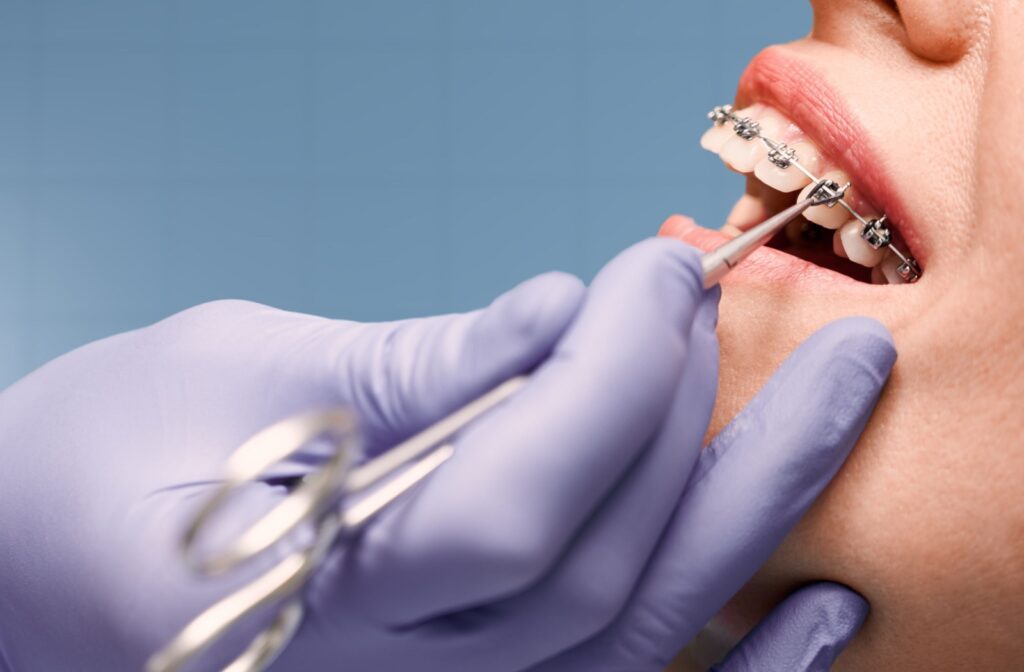
When you decide to straighten your teeth, you have a few great orthodontic options. Two common choices are Invisalign clear aligners and traditional braces. But which one works more quickly?
There’s no straightforward answer to this question. The choice between Invisalign and braces depends on the nature of your orthodontic issues, and one isn’t necessarily faster than the other. Your specific smile goals and the complexity of your case will ultimately determine your personal timeline.
How Treatment Time Varies for Invisalign & Braces
The total duration of your treatment depends on your specific needs. Orthodontic treatment can improve both the appearance of your smile as well as your oral health, but timelines for both teeth-straightening options can vary. Let’s explore the general timeframes for each.
Average Time for Invisalign
Invisalign treatment uses a series of custom-made, clear aligners to shift your teeth into position. For many cases, this process is quite efficient. The treatment length can often range from 6 to 18 months.
Your timeline is directly related to the amount of movement your teeth require. Simpler cases, like minor crowding, may be on the shorter end of this range. More complex bite issues might require a longer period to reach the desired outcome.
Average Time for Traditional Braces
Traditional braces use a system of brackets and wires to guide your teeth. This method is a reliable way to address a wide variety of orthodontic concerns. Treatment with braces can also last as little as 6 months, though many cases may take up to 24 months, and complex cases may take even longer.
This timeframe can vary for each person. The length of your treatment depends on factors like your bite alignment and the degree of correction needed. Regular appointments for adjustments are an important part of the plan.
Factors That Affect Your Treatment Timeline
Several key elements determine how long your orthodontic journey will take. Your smile is unique, and so is your treatment plan. Understanding these factors can help you understand what to expect.
The Complexity of Your Case
The extent of correction needed plays a significant role in the duration of your treatment. Straightening a few slightly misaligned teeth can often be done more quickly. Your starting point is a major factor in the overall timeline.
More involved issues, such as a deep bite or significant spacing, require more time to correct safely and effectively. Your dentist will conduct a thorough assessment to create a realistic schedule for your smile transformation.
Your Commitment to the Plan
Following your treatment plan is important for staying on schedule. Whether you have braces or Invisalign, your cooperation makes a difference. Your commitment helps you move toward your results efficiently.
For Invisalign, this means wearing your aligners as instructed. It’s helpful to remember these points:
- Wear your aligners for 20 to 22 hours per day.
- Change to your new set of aligners on schedule.
- Attend all your scheduled check-up appointments.
Your Body’s Response to Treatment
Everyone’s teeth move at a different pace. Your body’s response to the treatment can influence how quickly you see results. This is a natural part of any orthodontic process.
Your age and the density of your jawbone are both factors that can affect the speed of tooth movement. Your dental team will monitor your progress at every visit. They can adjust your plan based on how your teeth are responding.

The Experience: Comfort & Convenience
While the goal of correcting misaligned teeth is the same, the day-to-day experience with Invisalign and braces can feel quite different. Both are designed to be as manageable as possible throughout your treatment. This section explores what you might expect from each.
How Invisalign Feels
Invisalign aligners are made from a smooth, transparent plastic. They are custom-molded to fit snugly over your teeth. Most people find they get used to the feeling of wearing them very quickly.
When you switch to a new set of aligners, you might feel some gentle pressure. This is a good sign, as it means that your teeth are gradually moving. This sensation typically disappears within a day or so.
How Braces Feel
The main components of braces are small brackets and a connecting archwire. You may feel some tenderness in your teeth and gums after they are first put on or after an adjustment. This is temporary and a normal part of the process.
Sometimes, the hardware can rub against the inside of your mouth. Your dentist can give you orthodontic wax to place over any part that causes irritation. Your mouth will adapt to the feel of braces over time.
Daily Life with Aligners vs. Braces
Your daily routines—from eating to brushing your teeth—will adapt differently depending on your choice. Both options can be easily managed with a few small adjustments. It’s all about finding a new rhythm that works for you.
Eat & Drink With Ease
One of the conveniences of Invisalign is that the aligners are removable. You take them out for meals, so there are no food restrictions. You can continue to enjoy all your favourite foods throughout your treatment.
You can drink cool water while wearing your aligners. For any other food or drink, you should remove them first. Just remember to brush your teeth before you pop them back in.
Because braces can’t be removed, you eat and drink with your braces on. This means that certain hard or sticky foods aren’t compatible with braces.
Oral Hygiene Routines
Maintaining good oral hygiene is straightforward with Invisalign. Because you take the aligners out, you can brush and floss your teeth as you normally would. There are no brackets or wires to clean around.
With braces, you’ll need to learn some new skills to keep your teeth and gums healthy. Special tools like floss threaders and small brushes can help you clean around the hardware effectively. Your dental team will show you the helpful techniques for brushing and flossing.
How to Choose the Right Path for Your Smile
The best way to know which option is suitable for you is to have a conversation with a dental professional. They can look at your teeth, discuss your lifestyle, and help you understand your choices. This collaboration is key to a successful outcome.
Your Orthodontic Consultation
During a consultation, your dentist can assess your teeth and discuss your smile goals. They may use digital scans to get a precise look at your mouth. This visit is the perfect time to ask questions and share your expectations.
With this information, your dentist can recommend a treatment plan tailored to your needs. They’ll walk you through the steps, timeline, and what you can expect. The goal is to find a path that you feel comfortable with.
Questions to Ask Your Dentist
Coming to your appointment with a few questions can help you make an informed choice. You’ll leave feeling clear about your next steps. Consider asking these questions:
- What are the pros and cons for my specific situation?
- What is the estimated treatment time for each option?
- What does the total cost look like for each plan?
Choosing between Invisalign and braces is a personal decision based on your specific needs, lifestyle, and smile goals. Both are fantastic tools that help people achieve straighter, healthier smiles. The most important step is getting professional guidance.
Your Next Step to a Straighter Smile
The team at Generations Dental is here to help you explore your options in a relaxed and personalized way. We can answer your questions and help you decide on the right treatment for your smile. Contact us today to schedule your consultation.


